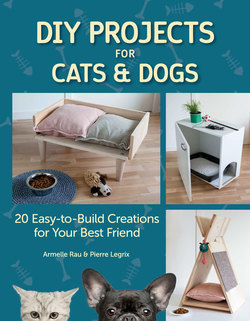Читать книгу DIY Projects for Cats and Dogs - Armelle Rau - Страница 6
На сайте Литреса книга снята с продажи.
ОглавлениеPRACTICAL BASICS
Materials
In this book, the main construction material used is wood—not fine wood, but wood that is easy to find, such as pine. Out of respect for the environment, we never use exotic woods. We sometimes use wood products, such as oriented strand board (OSB), which is easy to work with and affordable. It’s also aesthetically appealing and works really well with the uncluttered and understated current trends in home decorating. Plywood is another readily available option, and is often stronger than pine or OSB. You can also substitute particleboard, which is a little weaker, in some cases (but not for outdoor use).
All the other materials referenced in this book are easy to find at your local hardware store or home improvement store. As we are advocates for human contact when shopping, we believe a good merchant or salesperson will give you very good advice in selecting materials, so don’t be shy—ask for help and recommendations, and bring this book along while you shop!
Tools
You will notice that the tools we use are fairly common. They are also essential if you intend to build things yourself. Here are the four basic types of tools you’ll need.
Sandpaper. Sandpaper comes in different grits: fine grits for delicate and precise work, coarse grits for sanding or stripping. Having sheets of a few different grits on hand will make your work easier.
Saws. The first saw you will need is the jigsaw. Make sure you also buy plastic safety goggles. These will protect your eyes from flying debris and allow you to keep your eyes open, which in turn will help you keep your fingers out of harm’s way and help you saw accurately. Along with the jigsaw, you will need a handsaw and a miter box for making straight and angled cuts.
Power drill. You can’t build a lot of things without this tool. Almost all cordless power drills will accept both drill bits and screwdriver bits so that you can drill holes and drive screws with just one tool. You will need a variety of different sizes of bits, often included in the kit. If you’re purchasing a drill, choose a cordless battery-powered drill. If you have a cordless screwdriver, it is helpful, but it’s not a required purchase. Start by drilling a few holes in a scrap piece of wood to get used to handling the power tool. You shouldn’t have much trouble mastering it after a few minutes of practice.
To prevent wood from splitting when using screws, it’s important to drill pilot holes first—don’t just drill the screws straight into the wood. Drill pilot holes for every project in this book to ensure the best results.
Screws. These essential items can vary a lot in style and size. Buy wood screws for the building projects in this book. For some pieces, you may want to use black screws, which are more aesthetic and will blend in with your décor. Look for small diameters (so that you won’t see large screw heads everywhere). You will need a variety of screw lengths to make all the projects in this book. If you can, buy an assortment to always have a variety on hand. Otherwise, carefully review each project to ensure you select the best screws for the job before beginning. In general, screws should be long enough that you can get 1 to 1½ in (2.5 to 4 cm) of threads into the board you’re screwing to (as long as the board is thick enough to accommodate that).
Colors
We intentionally limited the colors used in the projects in this book. Our objective was not to save money on paint or brushes, but to make it easier for you to picture these pieces in your own home. Keeping them depersonalized here allows you to imagine how you will decorate them to your own taste. We can, however, advise you on a few points regarding the paints you will use.
First of all, the second coat of paint is always the most important—don’t neglect it. When the first coat of paint has dried, lightly sand the surface with fine-grit sandpaper. This will help the second coat of paint to adhere better.
If you want your project to be durable, don’t skimp on the quality of your paint. A better brand of paint can often guarantee quality and durability. We tend to prefer matte colors that blend in well with minimalist or Scandinavian interiors, but use whatever works for you.
Many of these projects will look good painted. For a high-quality finish, we recommend that you do not skimp on your paintbrushes. Whatever the size, avoid the lowest-priced brushes. They will lose their bristles and leave indelible marks on your new piece of furniture. On large surfaces, use a roller to save time and distribute the paint evenly. To prevent streaks, don’t forget to brush or roll the paint in one direction for the first layer, then in the opposite direction for the next layer.
